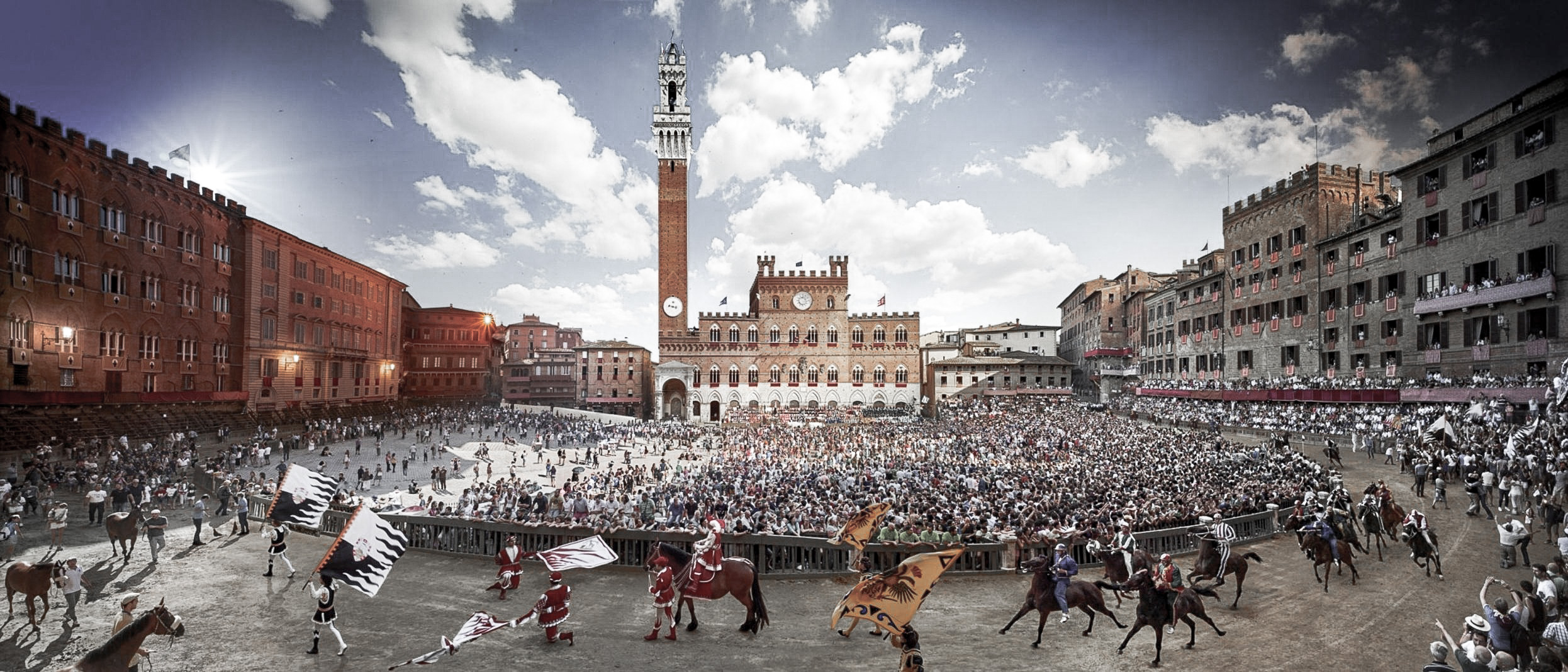Some experiences aren’t just events; they’re the heartbeat of a place, even the heartbeat of a lifetime. And for me, that’s the Palio di Siena.
But first, let’s go back to February 6th,1983. The Winds of War premiered that night, and the first episode featured Siena. At sixteen, I longed for romance and Italy—and it was Siena, in particular, and thereafter, that captured my imagination and filled my dreams. The central love affair between Byron Henry and Natalie Jastrow unfolded throughout the series but began in a villa’s library on the outskirts of Siena. They first laid eyes on each other before that distinctive cathedral, instantly recognizable for its striking black and white striped marble facade, which reflects the city’s symbolic colors.
Bryon and Natalie fell in love while researching history, picnicking on the hills, and attending the Palio, a medieval (literally) horse race in Italy.
What could be better?
I became obsessed. I bought, read, and reread Herman Wouk’s books. I immersed myself in World War II history. I avidly read a New Yorker essay on the Palio that explained the Contrade, the 17 wards of the city, and how they created community and maintained rivalries that went back centuries. The Contrade and their symbols entranced me.
They originated in the Middle Ages as military companies created to defend the city. Over time, as Siena became a prosperous republic and later part of the Grand Duchy of Tuscany, the Contrade evolved into social and civic institutions that organized community events, educated youth in tradition, and supported members in times of need. By the 18th century, the number of Contrade was reduced to 17 from over 50.
Being born into a Contrada is like a birthright. Each person is baptized twice in Siena—once in church and once in their Contrada‘s fountain. That’s so Italian! Loyalty runs deep, often passing from generation to generation. Each Contrada has a motto, a fountain (used for baptism), a museum of Palio victories, an oratory (chapel), and its own flag and marching band. They even baptize the horses that run the race!
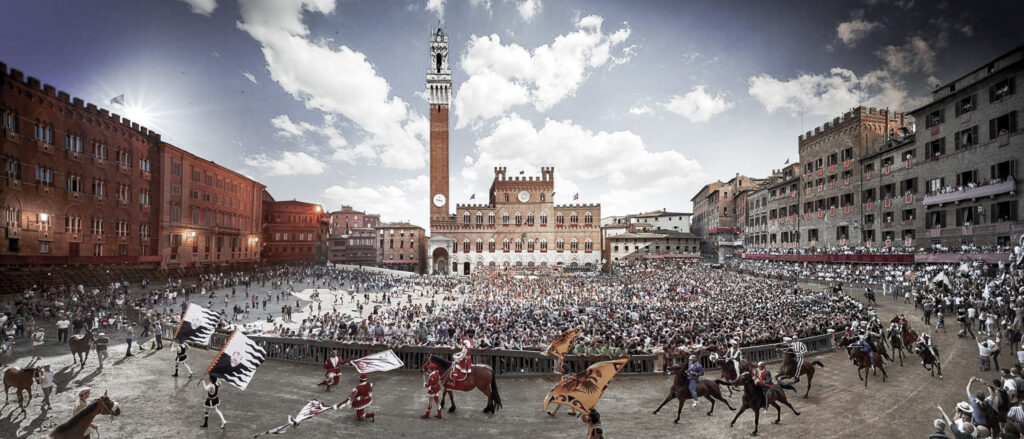
Many Contrade have centuries-old rivalries, often reflecting past feuds or neighborhood conflicts. The Tartuca vs. Chiocciola is among the most bitter as they share a border and a tense history (which, I kid you not, is the tortoise vs. the snail!) These rivalries play out with spirited chants, symbolic gestures, and even attempts to block the other Contrada‘s Palio efforts—but all within a framework of honor and tradition. It’s just amazing!
The 17 Contrade of Siena are:
- Bruco (Caterpillar) – Green caterpillar
- Chiocciola (Snail) – Red snail
- Civetta (Little Owl) – Owl
- Drago (Dragon) – Winged dragon
- Giraffa (Giraffe) – Giraffe with a crown
- Istrice (Porcupine) – Porcupine
- Leocorno (Unicorn) – Unicorn
- Lupa (She-Wolf) – She-wolf nursing Romulus and Remus
- Nicchio (Seashell) – Scallop shell
- Oca (Goose) – Goose with a crown and ribbons
- Onda (Wave) – Dolphin over waves
- Pantera (Panther) – Panther
- Selva (Forest) – Rhinoceros under an oak tree
- Tartuca (Tortoise) – Tortoise
- Torre (Tower) – Elephant with a tower
- Valdimontone (Ram) – Golden ram
I even bought a poster depicting the breathtaking, distinctive, shell-shaped brick campo and hung it on my wall during my first and second years in college. The image of Siena’s Piazza del Campo served as a constant echo that seemed to beckon me, and I swore that someday, I would make it to Siena.
The city transforms Piazza del Campo into a thundering, ancient racetrack with dirt and mud in the shade of siena. Not all 17 contradas are represented—only 10 are. The 7 Contrade that did not race in the same Palio the previous year are automatically entered, and the remaining three slots are picked by lot.
The Corteo Storico (Historical Parade) takes place before the Palio race.
It is a grand and meticulously choreographed procession showcasing Siena’s rich medieval heritage. Featuring more than 600 participants, including drummers, flag-throwers, pages, and knights in armor, each Contrada marches in full historical costume. The parade culminates with the carroccio (a ceremonial chariot bearing the Palio banner), drawn by oxen. The whole ceremony – the people, the costumes, the setting – resembles Zeffirelli’s 1968 enchanting rendition of Romeo & Juliet. No wonder I swooned.
After the Corteo, the ten horses and jockeys line up for the race itself in Piazza del Campo—making the transition from ritual to raw adrenaline. Ten bareback riders, decked in their Contrada colors, circle three times in a furious, passionate blur. They tie mattresses to the treacherous corners because horses and riders often slam into the walls. And yes, a riderless horse CAN win!
And trust me, if you look up old clips of the Palio, you’ll see that same bareback, full-commitment energy!
I can offer clients the unique opportunity to experience the Palio from an exclusive position—whether from a window or a balcony of one of the apartments overlooking Piazza del Campo.
In addition, you can enjoy the cena della prova generale, a traditional family-style dinner shared with locals in the streets of a Contrada. This special dinner, held in celebration of the upcoming race, is believed to bring good luck and is an unforgettable way to immerse in the festive spirit, surrounded by the vibrant colors and flags of the Contrada.
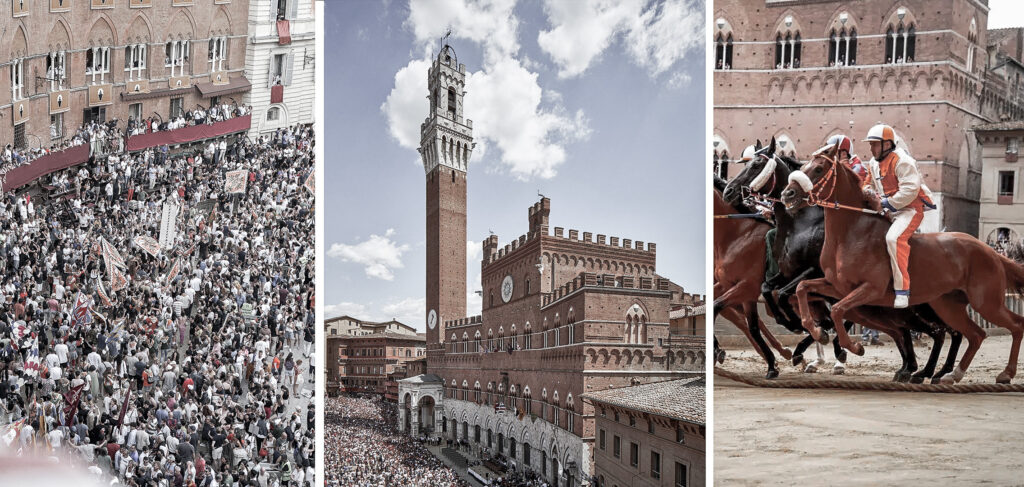
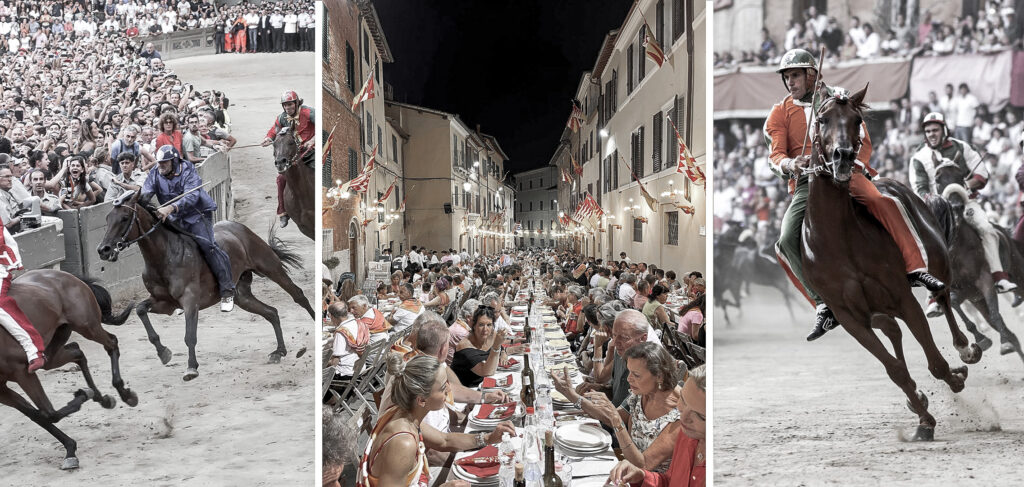
Yes, my friends, I made it there. I joined one of those street dinners. As a student, I couldn’t afford a seat to see it live. Plus, I was apprehensive about the unleashed excitement of the crowds. (I didn’t want to run with the bulls in Pamplona either!) But to be in Siena while this event occurred was truly extraordinary. The city and its history just pulled me in.
Twelve years after The Winds of War introduced me to Siena and the Palio, I traveled there to study law for a semester. And those months there changed me and the trajectory of my life.
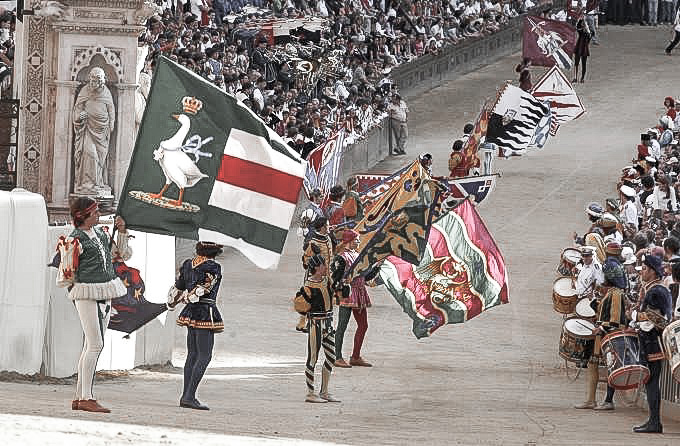
Two pieces of public art in Siena need mentioning. First, one of the most important and earliest secular artworks of the Middle Ages is Ambrogio Lorenzetti’s 14th-century fresco cycle, The Allegory and Effects of Good and Bad Government, and you can see it inside the Palazzo Pubblico. Commissioned by Siena’s ruling council, these murals visually articulate the ideals and consequences of governance – the very thing I studied that summer term. Good Government is personified on one wall by a wise ruler surrounded by virtues such as Justice, Peace, and Magnanimity. Its effects are shown in a bustling, harmonious city and fertile countryside—symbols of civic prosperity and moral order.
In contrast, Bad Government is ruled by Tyranny, flanked by personifications of Cruelty, Deceit, and War. The landscape is crumbling, citizens are afraid, and decay spreads both in the city and beyond its walls. Lorenzetti’s masterpiece is a powerful political message: governance shapes the soul of a city. These so fascinated me, I bought prints of both.
The second is the Allegory of the Mount of Wisdom,a mosaic designed by Pinturicchio in 1505 embedded in the floor of Siena’s Cathedral. I still remember the story told by our guide that connected the ancient Greek philosophers like Plato and Sibyls (pagan prophetesses) to Christianity. In 56 intricate and beautiful panels, you see a group of wise men, including ancient philosophers, climbing a rocky and challenging path towards the personification of Wisdom at the summit, a noble pursuit of knowledge and truth. Plato, along with figures like Socrates and Crates of Thebes, appears at the peak of this Mount of Wisdom. The philosophers strive to reach the highest form of wisdom through their intellect and moral fortitude.
This is presented as an arduous journey, often with temptations and obstacles symbolized by the winding path, scattered rocks, and even serpents. Renaissance humanists strove to reconcile classical thought with Christian theology, believing ancient pagan wisdom could prefigure or point toward Christian truth. That was the first time I realized that the Renaissance was more than a rebirth of the visual arts; it was more than Michelangelo carving David to look like a Greek god. This depiction sought to connect the ancient world’s philosophical foundations and thinking to Christianity. It mattered so much that someone commissioned this incredible work of art, and that moved me.
I have clients heading to Siena for a day later this summer, and I can’t wait to hear about their experience.
If YOU wish to visit and see the Palio, I’d love to send you – this year or next. Just reach out!
